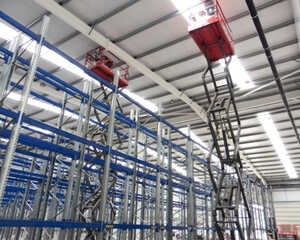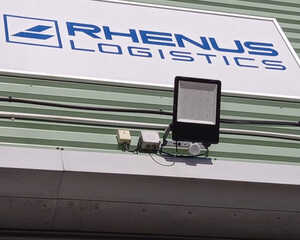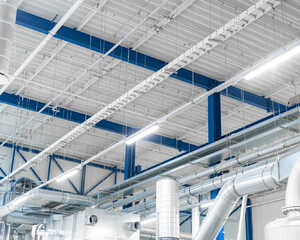
The shorter days, darker mornings, and earlier evenings of winter all place greater demand on your workplace lighting. For businesses, it’s essential to ensure that your lighting systems are ready to meet those seasonal challenges.
Poor lighting can lead to accidents, reduce productivity, and leave your site vulnerable to security risks. With energy prices remaining high, it also makes financial sense to assess your current systems and identify opportunities for savings.
Here are seven practical steps to help you prepare your business lighting for the winter months.
1. Check outdoor lighting and car park areas
Exterior lighting becomes far more important during winter. Entry points, walkways, and car parks are often in darkness during working hours, which can lead to safety risks for staff and visitors.
Inspect all external fittings to ensure they’re clean, functional, and correctly positioned. Replace faulty or dim units and ensure any controls – including timers or sensors – are correctly adjusted for earlier sunsets.
If you're still using halogen or older fluorescent lights, consider switching to LED floodlights with microwave sensors – which activate instantly when movement is detected, providing reliable lighting without wasting energy.
2. Test emergency lighting systems
Power cuts are more common in winter, particularly during storms. Emergency lighting systems ensure safe evacuation routes are visible in the event of an outage and should be tested regularly, especially before the winter season begins.
Confirm that all emergency fittings are functional, batteries are in good condition, and exit routes remain fully lit during test cycles. For added peace of mind, upgrade to self-testing LED emergency lights, which automatically check their own performance each month without manual intervention.

3. Evaluate indoor lighting levels
Reduced daylight during winter means your artificial lighting carries the full burden of illumination. If lux levels fall below recommended thresholds, it can affect concentration, cause visual strain, and increase the risk of workplace accidents.
Use a light meter to take readings in key areas such as production zones, stairwells, corridors, and office desks. If readings are too low – or too high – it may be time to redesign your layout or upgrade outdated fittings.
As members of the Institute of Lighting Professionals, we can advise on correct lighting levels and help ensure your workplace remains compliant with HSE guidance.
4. Adjust sensor settings and timers
Sensors and timers should be reprogrammed to align with seasonal daylight hours. Without adjustment, lights may switch on too late or remain off when needed most.
Microwave sensors are highly effective in winter conditions. Unlike passive infrared (PIR) sensors, which rely on heat detection, microwave sensors can pick up subtle movement in cold or poorly lit spaces. They also respond instantly and work well in areas like warehouses, stairwells, and exterior loading bays.
If your current system still relies on manual switching or PIR sensors, consider upgrading to automated controls for improved reliability and energy efficiency.

5. Clean fittings and check for degradation
Dust, grease, and general wear can reduce the output of your lights over time. This is especially true in industrial settings where airborne particles settle on fittings and lenses.
Cleaning your lighting should be part of routine maintenance, but winter is a good time to inspect for signs of degradation. Discoloured panels, yellowing diffusers, or flickering fittings may indicate it's time for replacement.
LED fittings with sealed units, IP-rated protection, and anti-glare lenses are ideal for environments that need consistent, reliable performance throughout the winter months and beyond.
6. Plan for extended use hours
Lighting systems typically run longer during the winter. What might have been a 6-hour daily use in summer can easily become 10–12 hours during darker months, and such extended run times place greater strain on older lighting technology.
Fluorescent tubes and halogen lights are particularly inefficient over long periods, often failing prematurely or causing excessive heat build-up. LEDs are far better suited to high-demand conditions, offering stable light quality, instant start-up, and lifespans of up to 100,000 hours.
Planning for increased usage now helps avoid costly mid-season breakdowns and downtime.
7. Look for energy-saving opportunities
Winter lighting doesn’t need to mean higher energy bills. In fact, it’s often the ideal time to review your lighting infrastructure for efficiency improvements.
Upgrading to ETL-compliant LED systems allows you to reduce electricity usage by up to 85%, especially when paired with smart controls like occupancy sensors and daylight harvesting. As well as cutting running costs, you also have the opportunity to reduce your carbon footprint – a growing priority for many businesses.
At LED Lights 4 You, we offer free lighting surveys that assess your current usage, identify areas for improvement, and project the long-term savings you could make.
Prepare now for a safer, smarter winter
Proactive maintenance and intelligent upgrades can make a real difference to how your workplace functions through the winter months. A well-lit environment supports safety, boosts productivity, and reassures both staff and visitors that your site is fit for purpose.
If you’re unsure where to start, our team can help you plan and implement a lighting strategy that delivers reliable results – no matter how dark the mornings get!
Book your free lighting survey today or speak to one of our specialists for advice on winter-proofing your business lighting.
Posted by Paul on October 27th 2025

